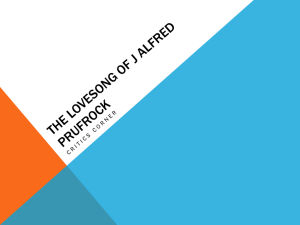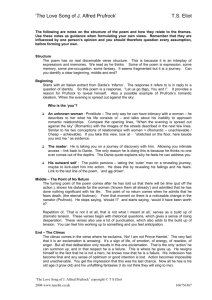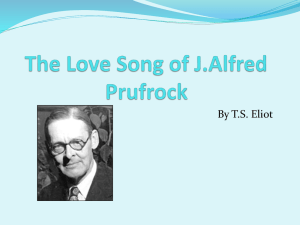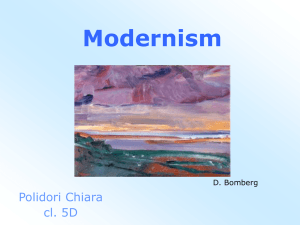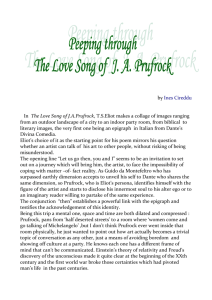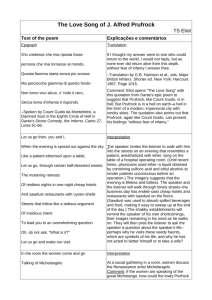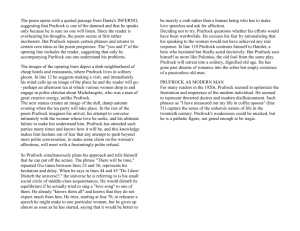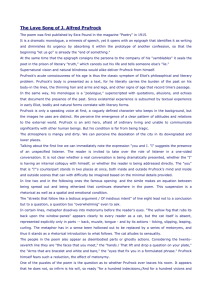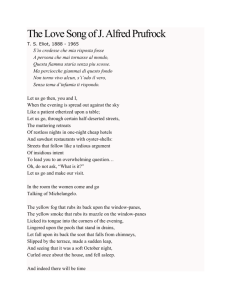THE LOVE SONG OF J
advertisement
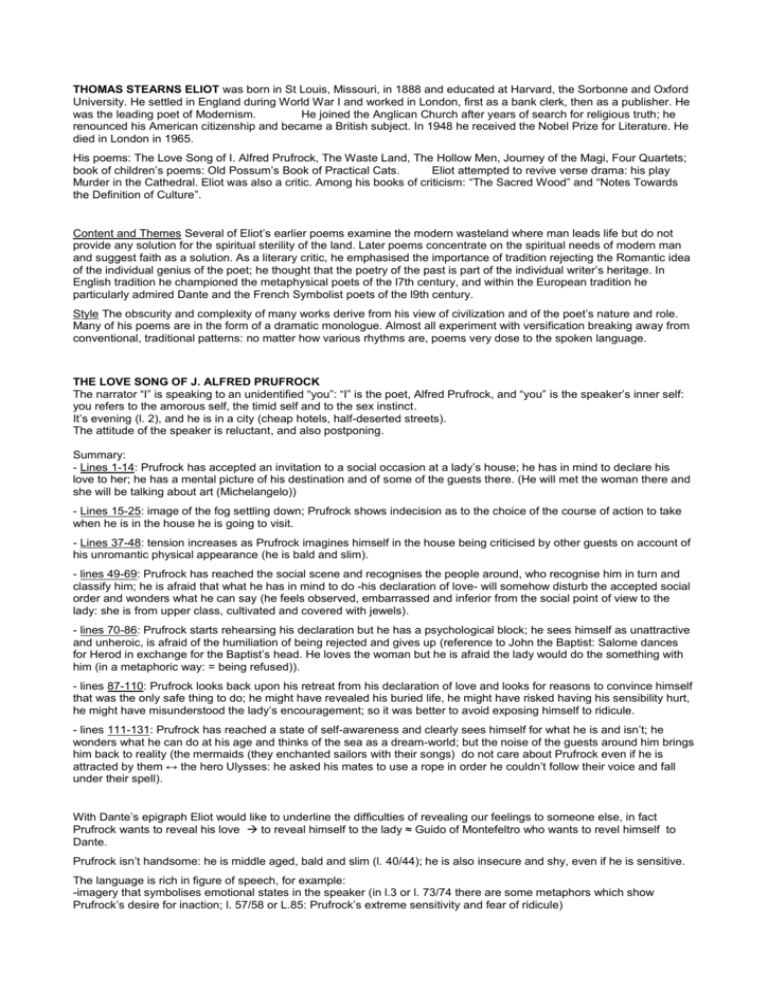
THOMAS STEARNS ELIOT was born in St Louis, Missouri, in 1888 and educated at Harvard, the Sorbonne and Oxford University. He settled in England during World War I and worked in London, first as a bank clerk, then as a publisher. He was the leading poet of Modernism. He joined the Anglican Church after years of search for religious truth; he renounced his American citizenship and became a British subject. In 1948 he received the Nobel Prize for Literature. He died in London in 1965. His poems: The Love Song of I. Alfred Prufrock, The Waste Land, The Hollow Men, Journey of the Magi, Four Quartets; book of children’s poems: Old Possum’s Book of Practical Cats. Eliot attempted to revive verse drama: his play Murder in the Cathedral. Eliot was also a critic. Among his books of criticism: “The Sacred Wood” and “Notes Towards the Definition of Culture”. Content and Themes Several of Eliot’s earlier poems examine the modern wasteland where man leads life but do not provide any solution for the spiritual sterility of the land. Later poems concentrate on the spiritual needs of modern man and suggest faith as a solution. As a literary critic, he emphasised the importance of tradition rejecting the Romantic idea of the individual genius of the poet; he thought that the poetry of the past is part of the individual writer’s heritage. In English tradition he championed the metaphysical poets of the l7th century, and within the European tradition he particularly admired Dante and the French Symbolist poets of the l9th century. Style The obscurity and complexity of many works derive from his view of civilization and of the poet’s nature and role. Many of his poems are in the form of a dramatic monologue. Almost all experiment with versification breaking away from conventional, traditional patterns: no matter how various rhythms are, poems very dose to the spoken language. THE LOVE SONG OF J. ALFRED PRUFROCK The narrator “I” is speaking to an unidentified “you”: “I” is the poet, Alfred Prufrock, and “you” is the speaker’s inner self: you refers to the amorous self, the timid self and to the sex instinct. It’s evening (l. 2), and he is in a city (cheap hotels, half-deserted streets). The attitude of the speaker is reluctant, and also postponing. Summary: - Lines 1-14: Prufrock has accepted an invitation to a social occasion at a lady’s house; he has in mind to declare his love to her; he has a mental picture of his destination and of some of the guests there. (He will met the woman there and she will be talking about art (Michelangelo)) - Lines 15-25: image of the fog settling down; Prufrock shows indecision as to the choice of the course of action to take when he is in the house he is going to visit. - Lines 37-48: tension increases as Prufrock imagines himself in the house being criticised by other guests on account of his unromantic physical appearance (he is bald and slim). - lines 49-69: Prufrock has reached the social scene and recognises the people around, who recognise him in turn and classify him; he is afraid that what he has in mind to do -his declaration of love- will somehow disturb the accepted social order and wonders what he can say (he feels observed, embarrassed and inferior from the social point of view to the lady: she is from upper class, cultivated and covered with jewels). - lines 70-86: Prufrock starts rehearsing his declaration but he has a psychological block; he sees himself as unattractive and unheroic, is afraid of the humiliation of being rejected and gives up (reference to John the Baptist: Salome dances for Herod in exchange for the Baptist’s head. He loves the woman but he is afraid the lady would do the something with him (in a metaphoric way: = being refused)). - lines 87-110: Prufrock looks back upon his retreat from his declaration of love and looks for reasons to convince himself that was the only safe thing to do; he might have revealed his buried life, he might have risked having his sensibility hurt, he might have misunderstood the lady’s encouragement; so it was better to avoid exposing himself to ridicule. - lines 111-131: Prufrock has reached a state of self-awareness and clearly sees himself for what he is and isn’t; he wonders what he can do at his age and thinks of the sea as a dream-world; but the noise of the guests around him brings him back to reality (the mermaids (they enchanted sailors with their songs) do not care about Prufrock even if he is attracted by them ↔ the hero Ulysses: he asked his mates to use a rope in order he couldn’t follow their voice and fall under their spell). With Dante’s epigraph Eliot would like to underline the difficulties of revealing our feelings to someone else, in fact Prufrock wants to reveal his love to reveal himself to the lady ≈ Guido of Montefeltro who wants to revel himself to Dante. Prufrock isn’t handsome: he is middle aged, bald and slim (l. 40/44); he is also insecure and shy, even if he is sensitive. The language is rich in figure of speech, for example: -imagery that symbolises emotional states in the speaker (in l.3 or l. 73/74 there are some metaphors which show Prufrock’s desire for inaction; l. 57/58 or L.85: Prufrock’s extreme sensitivity and fear of ridicule) -urban imagery and sea imagery (sea is the place of peace and non-action) -mock-heroic parallels (l.112 with the attendant lord of Hamlet, the one who isn’t a hero) Here are some features of the poem: irregular stanzas; irregular length of lines; random use of rhyme; alliteration (ex l. 34). The poem is a dramatic monologue, a l9th-centuiy poetic form which had the following main features: -a first-person speaker, a character separate from the poet -a listener, whose presence is to be inferred from clues in the speaker’s monologue -a specific time and place -revelation of something in the speaker’s character and life -tone of voice determined by the speaker’s personality and the nature of the event. Eliot has modified some features of the dramatic monologue: the speaker coincide with the listener (you is the same as I) split personalities. In spite of this, there are some typical features: for example the specific settings (even if here the places change: first the streets, then the city, the lady’s house, the imagery beach and sea) or the fact that the tone of voice changes with the development of the situation. Page 268: The Love Song of J. Alfred Prufrock has the form of a dramatic monologue in which the speaker, with an ironical tone aimed at himself, meditates on his failure to declare his love to a lady and about his inability to form relationships. His love song is the song of a being divided between passion and timidity. The poem develops a theme of frustration and of emotional conflict. In Prufrock there is a combination of memory and reflection. Development from one event or state of mind to another does not take place through logical connections, but through association of imagery. Eliot introduces a new poetic method: it originated from his scholarly studies of different literatures. Of the English tradition he appreciated the 17th-century “metaphysical” poets and John Donne’s use of “conceit”, an original figure of speech which revealed the poet’s search for an object adequate to express his feelings. From this idea Eliot formulated his theory of the “objective corre1ative” : for him the only way of expressing emotion in the form of art is by finding an ‘objective correlative’ in other words. + Eliot also spoke of the importance of studying other languages in order to enrich English with stimuli from continental and classical traditions, as he did for modern English poetry with his study of Dante and the French Symbolists. The novelty of his poetic method consists in replacing direct statement with metaphor and symbol (la fine di pag 268 e pag 269 sono su “the waste land” che noi non abbiamo fatto non le ho riassunte!!!!) IMAGISM page 266 Imagism is a cultural movement which fail under the general label of Modernism. It mainly concerned poetry and flourished in England and America between 1912 and 1917. The Imagists were influenced by Oriental poetry, especially by nature poems and short forms like the Japanese haiku. The typical imagist poet may deal with any subject matter, focuses on images that are precise and concentrated, adopts the vocabulary and rhythms of everyday speech and favours free verse. The leader of the movement was Ezra Pound. How he produced “In a Station of the Metro”: He saw a series of beautiful faces in a drab crowd in a Paris underground station and tried to find words for what this had meant to him. He wrote a poem about this experience in thirty lines, cut it down to ten lines, and finally arrived at the following “one image poem” of two lines. IN A STATION OF THE METRO The apparition of these faces in the crowd: Petals on a wet, black bough. The poem presents us with a wet black branch of a tree covered with blossoming flowers. The image conveys suggestions of joy and beauty (“petals”) that can be found even in a negative context, generating a pleasant surprise. ALBA As cool as the pale wet leaves of lily-of-the-valley she lay beside me in the dawn. Simile which appeals to the sense of touch and to the sense of sight. The image conveys suggestions of pleasure, freshness, delicacy and beauty. The poem is in free verse. Rhythm is irregular, lines are of varying length, and rhyme is absent. Alliteration of I.
